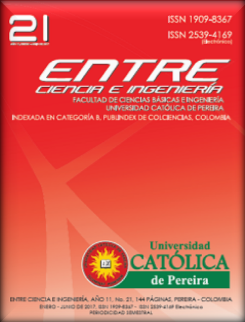Integration of didactic and neuroscientifi c strategies to improve motivation and learning in basic chemistry courses
DOI:
https://doi.org/10.31908/19098367.3286Keywords:
chemical equilibrium, lactic fermentation, multisensory stimulation, motivation, TfUAbstract
This paper exposes a methodological approach that was designed and developed to facilitate the understanding of the topic chemical equilibrium; a familiar context for students was used. The proposal was applied to an average population of about 16- year-old. The context was the process used to produce yogurt in a lab under the methodological strategy: Teaching for Understanding (TfU). The proposal also relies on neuroscientifi c foundations of learning that take into account the need to generate attention statements prior academic work, to improve understanding of concepts and pitch them to the long-term memory by stimulating multisensorial; this stimulation may improve better synaptic connections. Before starting the academic work, stimulation activities were conducted, which resulted in a state of attention and motivation that allowed students to make observations and analysis at the macroscopic level, to fi nally understand precisely the chemical process lactic fermentation, as a reversible process produced by the action of microorganisms.
References
A. Nergis, «To what extent does neurolinguistics embody EFL teaching methods?», Procedia - Soc. Behav. Sci., vol. 15, pp. 143-147, 2011.
M. S. Summak, a. E. G. Summak, y P. Ş. Summak, «Building the connection between mind, brain and educational practice; roadblocksand some prospects», Procedia - Soc. Behav. Sci., vol. 2, n.o 2, pp.1644-1647, 2010.
E. Kandel, T. Jessell, y J. Schwartz, Neurociencia y Conducta. 1997.
E. Jensen, Cerebro y Aprendizaje. Competencias e implicaciones educativas. Madrid, 2004.
L. Galagovsky, M. A. Rodriguez, N. Stamati, y L. Morales, «Representaciones Mentales, lenguajes y códigos de la enseñanza de ciencias naturales. Un ejemplo para el aprendizaje del concepto de reacción química a partir del concepto de mezcla.», Enseñanza las Ciencias, vol. 21, n.o 1, 2003.
I. Aguerrondo y P. Pogré, Escuelas del futuro II. Cómo planifican las escuelas que innovan. 2001.
F. Gómez Pinilla, Y. Zhuang, J. Feng, Z. Ying, y G. Fan, «Exercise impacts brain-derived neurotroophic factor plasticity by engaging mechanisms of epigenetic regulation.», Eur. J. Neurosci., vol. 33, n.o 3, pp. 383-390, 2011.
L. M. Ibarra, Aprende Mejor con Gimnasia Cerebral. 2007.
Ministerio de Educación Nacional, Estándares Básicos de Competencias. 2006.
A. Rocha, «Dificultades en el aprendizaje del equilibrio químico», ADAXE-Revista de Estudios e Experiencias Educativas, n.o 16. pp.163-178, 2000.
A. Raviolo, «Implicaciones didácticas de un estudio histórico sobre el concepto de Equilibrio Químico.», Enseñanza las Ciencias, vol.25, n.o 3, pp. 415-422, 2007.
M. Izquierdo, N. Sanmartí, y M. Espinet, «Fundamentación y diseño de las prácticas escolares de ciencias experimentales», Enseñanza las Ciencias, vol. 17, n.o 1, pp. 45-59, 1999.
M. F. Molina, D. M. Farias, y J. A. Casas, «El Trabajo Experimental en los Cursos de Química Básica», Memorias CIIEC, n.o 1, pp. 51-59, 2006.
M.F. Molina, L.A. Palomeque, y J.G. Carriazo, “Experiencias de Enseñanza de la Química con kits de Laboratorio”, Entre Ciencia e Igeniería, No. 20, pp 76-81, 2016
N. Yildirim, Y. Şengün, Z. Ceng, y A. Ayas, «Evaluating the effect of teaching chemical equilibrium based on analogy and laboratuary on students achievement», Procedia - Soc. Behav. Sci., vol. 2, n.o 2, pp.537-541, 2010.








 Revista Entre Ciencia e Ingeniería
Revista Entre Ciencia e Ingeniería .png) entrecei@ucp.edu.co
entrecei@ucp.edu.co.png) ISSN (Impreso) 1909-8367 - ISSN (En Línea) 2539-4169
ISSN (Impreso) 1909-8367 - ISSN (En Línea) 2539-4169 Attribution-NonCommercial 4.0 International (CC By-NC 4.0)
Attribution-NonCommercial 4.0 International (CC By-NC 4.0)
.png) Carrera 21 No. 49-95 Av. de las Américas, Pereira, Risaralda, Colombia
Carrera 21 No. 49-95 Av. de las Américas, Pereira, Risaralda, Colombia